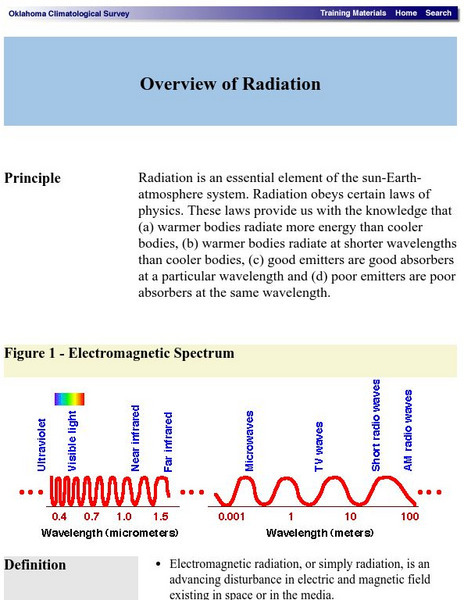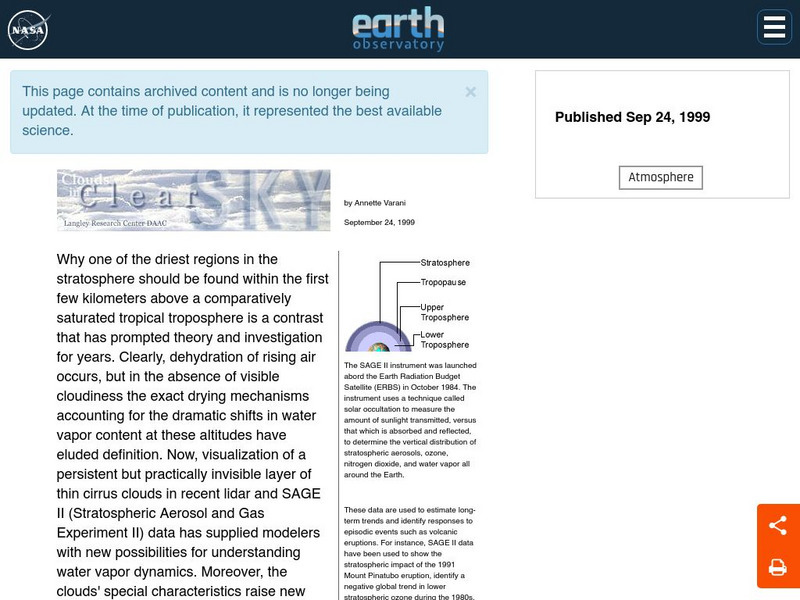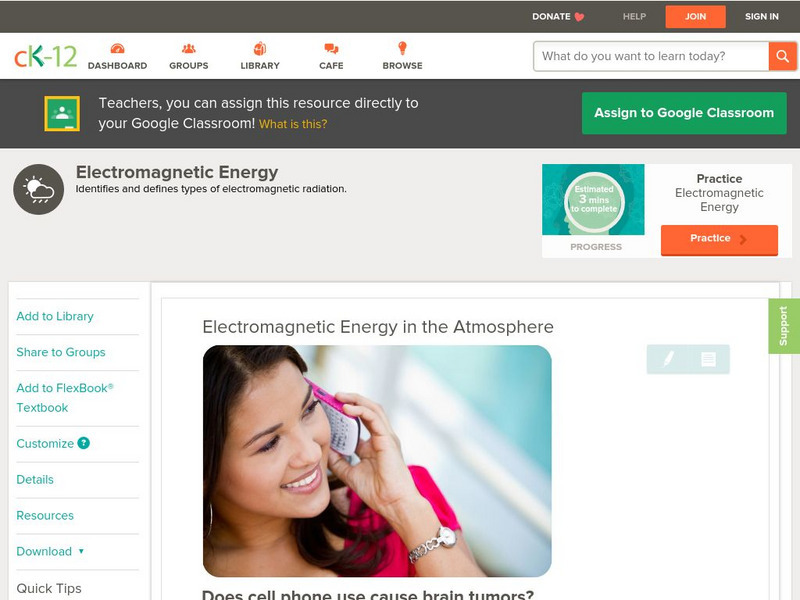Hi, what do you want to do?
Exploratorium
Exploratorium: Global Climate Change: Atmosphere
Use this site to explore real scientific data relating to the atmosphere. With this information you can gather evidence, test theories, and come to conclusions. Click on the data examples to view a full scale version.
Oklahoma Mesonet
Oklahoma Climatological Survey: Earth's Energy Budget
This 2-part resource details how the Earth absorbs just enough energy from the Sun to sustain life. Content explores incoming solar radiation and outgoing terrestrial radiation.
NASA
Nasa: Effect of the Sun's Energy on the Ocean and Atmosphere
A project based lesson where students' mission is to conduct a series of tasks that enable them to audit Earth's energy budget and help answer a number of science questions.
Encyclopedia of Earth
Encyclopedia of Earth: Local and Regional Wind Systems
Read about regional and local wind systems, including information on changes in atmospheric pressure, thermal energy in the atmosphere, sea and land breezes, mountain and valley breezes, and monsoon winds.
Climate Literacy
Clean: Introduction to Earth's Climate
This lesson is an introduction to Earth's climate and covers key principles regarding Earth's unique climate, atmosphere, and regional and temporal climate differences. Students will gain an understanding of how the weather and climate...
NASA
Nasa Earth Observatory: Global Maps: Net Radiation
View a global map from NASA's Earth Observatory that shows net radiation from July 2006 to November 2008. Learn about radiation and the balance between incoming and outgoing energy in the atmosphere.
Cosmo Learning
Cosmo Learning: The Atmosphere, the Ocean, and Environmental Change
A collection of video lectures from a course that explores the physical processes the control Earth's atmosphere, ocean, and climate that is taught at Yale University. The course covers topics like clouds, rain, severe storms, regional...
CK-12 Foundation
Ck 12: Earth Science: Effect of Atmospheric Circulation on Climate
[Free Registration/Login may be required to access all resource tools.] Looks at how atmospheric circulation cells affect the climate of regions.
University Corporation for Atmospheric Research
Ucar: Learn: The Greenhouse Effect
A detailed overview of the greenhouse effect, with explanations about Earth's atmosphere gases referred to as greenhouse gases, and the factors that influence the heat-trapping ability of a greenhouse. All information is reinforced...
Open Curriculum
Open Curriculum: Into the Mitochondrion: Making Atp With Oxygen
The aim of this article is to relate the history of oxygen in the atmosphere to the evolution of photosynthesis, aerobic respiration, mitochondria, and life on earth.
Oklahoma Mesonet
Oklahoma Climatological Survey: Overview of Radiation
This site details what radiation is, the physics of radiation, and radiative transfer as it occurs in nature. Content explores the electromagnetic spectrum, electromagnetic waves, properties of radiation, and solar radiation.
CK-12 Foundation
Ck 12: Earth Science: Electromagnetic Energy in the Atmosphere Study Guide
[Free Registration/Login may be required to access all resource tools.] Summarizes the key points about electromagnetic waves and how they are classified. Includes a few questions to check for understanding.
NASA
Nasa Earth Observatory: Clouds in a Clear Sky
This article introduces the different layers of the atmosphere and the clouds that are formed there. Scientists use instruments such as the SAGE 11 that help to measure amounts of sunlight, water vapor, and other conditions that affect...
NOAA
Noaa: Weather Systems and Patterns
Imagine our weather if Earth were completely motionless, had a flat dry landscape and an un-tilted axis. This, of course, is not the case; if it were, the weather would be much different. The local weather that impacts our daily lives...
Geographypods
Geographypods: Patterns in Environmental Quality and Sustainability
This collection of five learning modules looks at issues related to environmental change and sustainability. Topics addressed include changes in the atmosphere, soil, water, and biodiversity, and what can be done to counteract this and...
Climate Literacy
Clean: Climate Feedback Loops
This is the seventh of nine lessons from a student learning module called "Visualizing and Understanding the Science of Climate Change." This lesson addresses climate feedback loops and how these loops help drive and regulate Earth's...
Concord Consortium
Concord Consortium: Stem Resources: Greenhouse Gases
Do you understand the relationship between temperature and carbon dioxide in our atmosphere? This computer model shows factors such as clouds and carbon dioxide that could cause global temperatures to rise. Students investigate how the...
Other
Digital Library for Earth System Education: Teaching Box: Essentials of Weather
A suite of lessons focusing on the basic elements of climate and weather. Inquiry-based exploration of extreme weather events and the factors of weather including clouds, wind, air pressure, temperature, and the water cycle.
Science Buddies
Science Buddies: Tracking Geomagnetic Storms in the Ionosphere
The Sun is the ultimate source of the energy that powers weather systems on Earth. Geomagnetic storms are sun-powered storms in the upper atmosphere, arising from energized particles that are periodically ejected by the Sun. Among other...
Idaho State University
Global Wind Systems [Pdf]
A great description of the global scale circulation and heat energy. Discusses a single-cell model, a three-cell model, jet streams and more.
CK-12 Foundation
Ck 12: Earth Science: Electromagnetic Energy in the Atmosphere
[Free Registration/Login may be required to access all resource tools.] Overview of electromagnetic radiation.
CK-12 Foundation
Ck 12: Earth Science: Electromagnetic Energy in the Atmosphere
[Free Registration/Login may be required to access all resource tools.] Overview of electromagnetic radiation.
PBS
Pbs Learning Media: What Causes the Gulf Stream?
This video segment adapted from NOVA uses satellite imagery to illustrate the Gulf Stream's path and animations to explain how atmospheric phenomena cause it to move. [1:51]
Other
Conservation Corps Newfoundland and Labrador: Climate Change Club
Join the fun at the Climate Change Club where you can find out ways to take action at home, in school, and in your community. Keep up with the latest news in climate science, and link to fact sheets and other fun sites that care about...






















